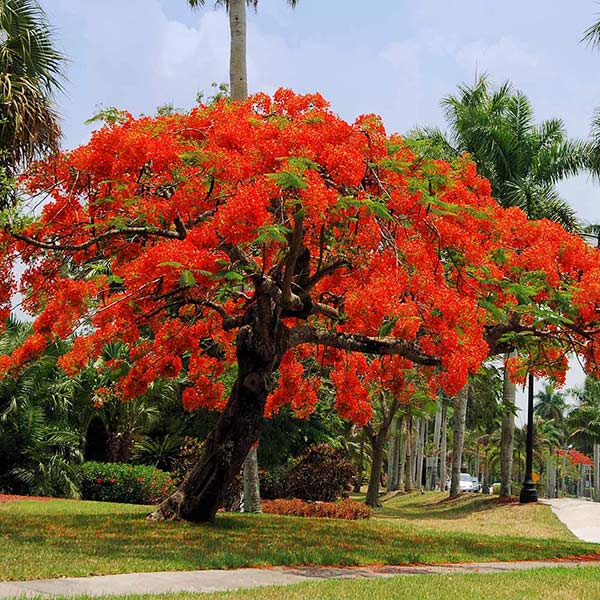Welcomes Spring with Flame-Colored Blooms
Why Royal Poinciana Trees?
Marking the start of spring each year with thousands of bright red blooms, the Royal Poinciana Tree’s rich color is not commonly seen in other flowering varieties. In fact, it’s also called the ‘Flame Tree’ for its blazing color.
While many others offer pink or white flowers at the start of the season, the Poinciana’s flame-colored hues stand out. In fact, Poinciana Trees are often the brightest trees in the neighborhood, attracting the attention of guests and neighbors alike.
And the Poinciana’s lush, long slender leaves offer a tropical look against its crimson blooms. Plus, because Poincianas are semi-evergreen, they won't lose their leaves in warmer climates. and will provide your yard with abundant green foliage all year.
Even better? Because they can grow up to five feet a year, you get these exotic colors and shade quickly. So, not only do you get one-of-a-kind beauty, but you also get a tree that shields your home from the summer heat and provides extra insulation in the winter, saving you money and energy from season to season. And these vigorous growers have an extremely high drought tolerance and grow well in the dry, sandy areas where other flowering trees can't take the heat.
Why Fast-Growing-Trees.com is Better
Transforming any landscape, even one with tough growing conditions, into a relaxing oasis, your Poinciana Tree is second to none. Especially when you order from Fast Growing Trees since we’ve planted, grown and nurtured your Poinciana, long before shipping.
Now, your Royal Poinciana is shipped to your door with a healthier root system, better branching and a head start on growth. And with our larger sizes, you’ll see blazing color and shade as soon as the first season.
Don't miss your chance – Poincianas are selling out fast and we recommend getting yours today, before they're gone. Order the vibrant red hues of your Royal Poinciana today!
Planting & Care
1. Planting: Select a location with well-drained soil and plenty of sunlight (6 to 8 hours of sunlight per day). Dig a hole that’s three times as wide and equal in depth as the root ball. Remove your plant from its original container, position into the hole ensuring that it’s standing upright, and the top of the root ball is even with the ground.
Begin backfilling the hole, tamping down lightly as you go. Once the hole has been completely filled, water to allow the soil to settle and eliminate any air pockets. Finally, apply a 3 to 5-inch layer of mulch around the plant to help enrich the soil as well as conserve moisture and control weeds.
2. Watering: We recommend watering your Poinciana once or twice weekly. If you’re not sure when to water, simply check the top 2 inches of soil for dryness. If the soil is dry here, it’s time to water.
3. Fertilizing: Apply a slow-release fertilizer once a year in early spring, before new growth emerges. Then, water the surrounding soil to allow the fertilizer to penetrate into the roots. Follow the application instructions on the fertilizer.
4. Pruning: Minimal pruning is needed. Any broken branches can be pruned back in spring before new growth begins.





Comment